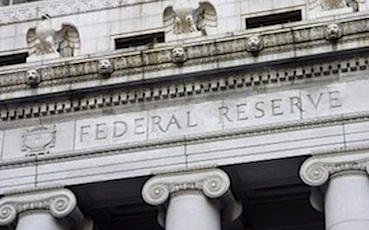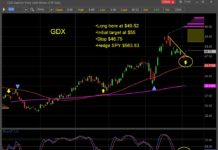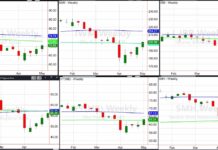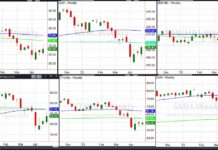Danielle DiMartino Booth, a former Dallas Federal Reserve official, released a new book this week entitled Fed Up. The book, a first-person account of the inner-workings of the Federal Reserve (Fed), provides readers with unique insight into the operations, leadership, and mentality of what is unquestionably the world’s most powerful financial force. This column serves as my personal review and opinion of the book.
What it reveals about the Federal Reserve is neither flattering nor confidence-inspiring. By pulling back the curtain to reveal the Fed’s modern-day machinations, DiMartino Booth provides an assessment of the highest levels of economic thinking and how it is afflicting our economy.
Throughout the book, it is clear her purpose is equal parts entertainment and education with a dash of sermon to underline the gravity of the situation. Fed Up is compelling, well-written and its objectives are clear; expose the hubris at the Fed which results in poor decision-making and generate much-needed debate to bring about change in how the Fed functions. As you read this review, and hopefully the book as well, we remind you the Fed is sworn to serve the American public and should be held accountable to this obligation.
We thank Danielle for giving us the privilege of reading an advance copy of her book so that we can provide this timely review to you. Neither 720Global, LLC nor its owners have received any form of direct or indirect compensation in exchange for the review of this book.
Confluence of Events
Skill, talent, temperament and career path often have a funny way of converging at just the right time to produce something that is needed at a particular moment to change the course of events. Danielle DiMartino Booth’s Wall Street experience and tenure as a journalist converge with her personal traits of curiosity, healthy skepticism and integrity to expose the powerful forces of the Fed and the means by which they use their influence.
DiMartino Booth spent enough time on Wall Street to become “enlightened” as to the ways of high finance and then went on to pursue a career in journalism at the Dallas Morning News. Her insight and warnings in the years preceding the Great Financial Crisis of 2008 are well-documented and stand in stark contrast to the mindset of the Fed and then-chairman Ben Bernanke who “found little evidence to support the existence of a national home price bubble.” Fortunately, the President of the Dallas Federal Reserve Bank, Richard Fisher, was a rare exception within the Fed and took notice of DiMartino Booth’s articles. In the fall of 2006, Fisher convinced her to join the Dallas Research Department.
Theory Versus Practice and a Dose of Hubris
 From her early days at the Dallas Fed, DiMartino Booth recognized that the Federal Reserve is run by Ph.Ds. from the premier economic schools of the nation. Referring to them as the “MIT mafia,” she notes that the large concentration of academicians at the Fed is a recent trend. Traditionally, Fed governors hailed from the banking sector where they came equipped with a deeper understanding of the workings of the main street economy and a real-world perspective of the benefits and consequences that accompany monetary policy. In years’ past, the practical experience of leadership naturally guided academically-oriented researchers and analysts on staff. According to DiMartino Booth, Richard Fisher was a Fed President of this mold. Unfortunately, the influx of Ph.Ds. over the last 15 to 20 years with virtually no practical experience changed the Fed’s thinking. In her words, “the overwhelming dominance of academics goes a long way toward explaining why the financial crisis of 2008 blindsided the Fed”.
From her early days at the Dallas Fed, DiMartino Booth recognized that the Federal Reserve is run by Ph.Ds. from the premier economic schools of the nation. Referring to them as the “MIT mafia,” she notes that the large concentration of academicians at the Fed is a recent trend. Traditionally, Fed governors hailed from the banking sector where they came equipped with a deeper understanding of the workings of the main street economy and a real-world perspective of the benefits and consequences that accompany monetary policy. In years’ past, the practical experience of leadership naturally guided academically-oriented researchers and analysts on staff. According to DiMartino Booth, Richard Fisher was a Fed President of this mold. Unfortunately, the influx of Ph.Ds. over the last 15 to 20 years with virtually no practical experience changed the Fed’s thinking. In her words, “the overwhelming dominance of academics goes a long way toward explaining why the financial crisis of 2008 blindsided the Fed”.
Further reading from Michael: The Lowest Common Denominator: DEBT
Prominently throughout the book, DiMartino Booth highlights the arrogance and hubris that these academics-turned-central bankers possessed and the control they garnered. They believed that their textbooks, unproven theories, and complex research papers provided new sophistication and certainty with which to manage the domestic and, indeed, the global economy. They shelved simple models, and all but ignored real-time market data and the word on the street. In their pursuit of certainty, they forgot that human behavior could not be replicated in a petri dish.
This myopic academic perspective affected the staff economists and spread to the upper echelons of the Federal Reserve. As DiMartino Booth writes, “not that Bernanke wasn’t listening, but over time, he fixated on academic theories. Real life reports by Fisher and other District Bank presidents counted for little.” She added that current Federal Reserve Chairwoman Janet Yellen, who at the time ran the San Francisco Fed, was “more married to her models than Greenspan and Bernanke combined.”
Despite warnings from DiMartino Booth and Fisher, the Fed failed to see that “Malignant stars were aligning for a once-in-a-century global economic meltdown. Though precious few inside the Fed saw the crisis coming, it is patently false to suggest insiders hadn’t been fairly warned”.
As concerning as the Fed’s myopia was, she found their hubris equally troubling. From the Fed Governors and district presidents down to the staff Ph.Ds.’ the air of royalty and elitism permeated the atmosphere. Many of these economists lived in vacuums, where assumptions about human behavior and intricate modeling replaced real world experience and observation. It should be no surprise therefore that DiMartino Booth and Fisher, lacking Ph.Ds.’ were generally ignored despite their repeated expression of concern and warning.
Driving Animal Spirits
In giving us the proper perspective on the events of the financial crisis and the Fed response, DiMartino Booth effectively lays the ground work for historical events that influenced future course. She describes the sequence of events beginning ten years earlier that would formally establish the ultimate term describing financial moral hazard, “the Greenspan Put.”
The once-mighty hedge fund, Long-Term Capital Management (LTCM), run by the so-called best and brightest Ph.Ds. (a theme that should start to sound familiar by now), including two Nobel Prize winning board members, thought they had developed a means by which they could guarantee profits from derivative trading. When their theories and models didn’t align with reality, massive losses ensued, and Wall Street was holding the risk. Federal Reserve Chairman Alan Greenspan, along with Treasury Secretary Robert Rubin and Treasury official Lawrence Summers, orchestrated a government-sponsored bailout of the hedge fund.
The LTCM bailout – to be clear, the American taxpayer bailout of a hedge fund and in turn Wall Street – sent a very clear “risk-on” signal to major financial institutions and investors which elevated Greenspan and company to a status akin to deity. Per DiMartino Booth: “They were hailed as geniuses. I imagined my fellow Wall Streeters going to the cathedral in my neighborhood and lighting candles. Thanks be to God and Greenspan”.
Fast forward to the aftermath of the 2008 crisis, and through many different forms of extraordinary and highly questionable monetary policy, DiMartino Booth makes a case that the Fed remains overly concerned with spurring animal spirits. In other words, they believe that continually boosting investor confidence and driving financial asset prices higher is a necessity. In DiMartino Booth’s words “and yet here was the Fed, with Yellen as its biggest cheerleader, once again trying to build an economic recovery on the back of frenetic animal spirits.” In the Fed’s mind, Bear Stearns, Lehman, Fannie Mae and other institutions lay testimony to what happens when the free markets are left to their own devices. Left out of their discussion, however, was the role the Fed might have played in creating the problems through ill-advised policy.
DiMartino Booth makes clear that Fed officials have both the free hand and the lack of humility to disregard the potential negative implications for the average citizen while at the same time emphasizing the needs of their primary constituent – Wall Street. The Fed’s tactics are not just about investor confidence but backed by a faulty theory called the wealth effect. They erroneously associate financial asset inflation to wealth generation and wealth generation to prosperity for all. In retrospect, they either failed to recognize that artificially manipulating markets higher would predominately benefit the wealthy or they knew this but elected not to disclose it. In DiMartino Booth’s words “The problem was the bulk of these trillions was in the hands of a few. Those who were most insulated from the needs to earn a living were driving the rally. Any middle-class recovery was an illusion.” Further “Who will pay when this credit bubble bursts? The poor and the middle-class, not the elites. If those injured most by Fed policy could understand, they would be marching at Yellen’s door with protest signs, screaming show us the wealth effect!”
Transparency
Touted increasingly by the Bernanke and Yellen regimes, emphasis on improving Fed transparency appears to be nothing more than a self-serving ruse designed to deflect congressional efforts to regulate the Fed. DiMartino Booth explains that, although intended to highlight the substance of Federal Open Market Committee (FOMC) meeting discussions, published FOMC minutes are altered well after the meeting to mollify Wall Street’s and the markets’ interpretation of the original statement. She also discloses that Bernanke and Yellen brazenly “leak” information to the press to suit various purposes. Such purposes may include efforts to “correct” markets when desired or even as a bully tactic aimed at Fed members that may have stepped out of line with the Chairman’s preferences.
Fixing the Fed
DiMartino Booth is not supportive of the extreme call by some to “end the Fed”, but she firmly believes there needs to be dramatic reform. The various recommendations she offers include specific suggestions involving the way monetary policy is formed and implemented as well as the objectives of such policy. Many of the economic woes facing the nation are either a direct or indirect result of an over-imposing and ham-handed monetary policy approach based on intellectual arrogance. She makes a compelling plea for change, listing numerous reasonable actions that should be undertaken to improve the Fed’s influence over the economy to the benefit of all Americans, not just the wealthy.
Summary
Wealth inequality, wage stagnation, massive debt loads, feeble economic growth and weak productivity growth are but a few of the economic and social problems that are the legacy of poor monetary policy. Less than a decade after the Financial Crisis, we are again confronted with asset prices perched well above fundamentals, an unfettered shadow banking system and an even larger concentration of too-big-to-fail banks. Additionally, unprecedented interest rate policy is complicit in allowing lawmakers and the U.S. Treasury to shirk their fiscal responsibilities and recklessly expand the national debt. It is unbecoming and irresponsible for Fed officials to continually neglect to accept any role in the prior two economic bubbles and the one now festering.
What DiMartino Booth describes in Fed Up is the manifestation of years of central bank evolution. To the academics who occupy the chairs in the Marriner Eccles Building today, it is the blooming flower of the seeds planted by John Maynard Keynes and nurtured by Alan Greenspan, Ben Bernanke, and Janet Yellen. The reality, as so well described by DiMartino Booth, is that of an intellectual contagion. The role the Federal Reserve has assumed today better resembles that of a global virus. By way of multiple global financial crises over the past 30 years, their influence and power have adapted and spread to cover all of the developed world.
By pulling back the curtain on this reality, DiMartino Booth accomplishes what may be the first meaningful step toward properly diagnosing an important source of present day economic illness. Fed Up provides a post-crisis update of how the Federal Reserve runs the country with substantial evidence of the short-cuts and manipulations employed as a means to their ends. The recommendations offered in the book are reasonable and actionable but will certainly be viewed as a threat to Fed independence. It is that independence which has served as the enabler of a powerful, un-elected governing body which bears no accountability or burden of proof for its actions. The time to reign in and redefine how the Fed operates is past due and Fed Up offers not only the rationale but a potent and lucid blueprint for doing so.
If interested, you can order a copy of Fed Up by Danielle DiMartino Booth here.
Author Note: Neither 720Global, LLC nor its owners have received any form of direct or indirect compensation in exchange for the review of this book.
Twitter: @michaellebowitz
Any opinions expressed herein are solely those of the author, and do not in any way represent the views or opinions of any other person or entity.








